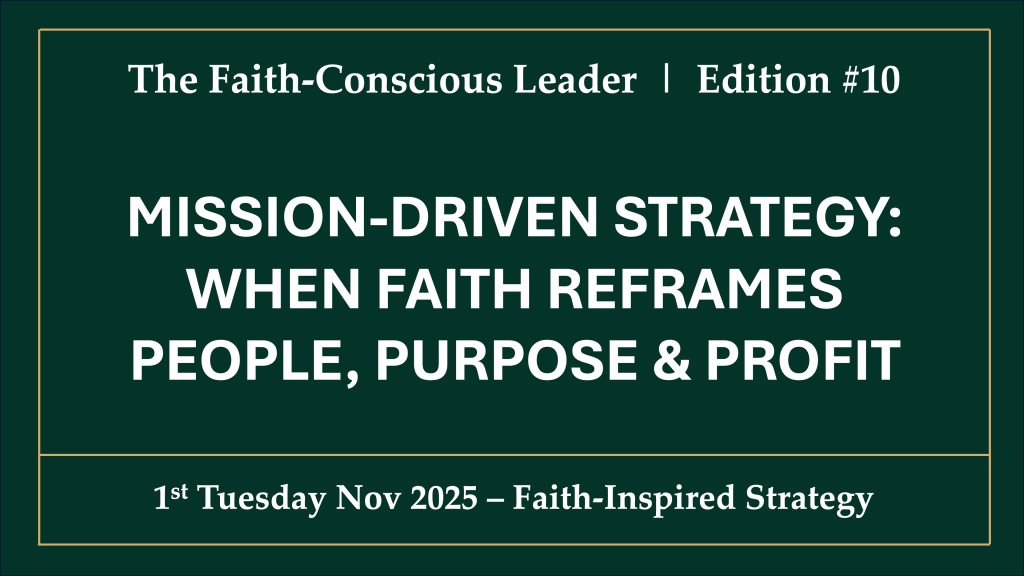Mission-Driven Strategy: When Faith Reframes People, Purpose & Profit

– How Muslim leaders can translate mission-oriented frameworks into faith-conscious strategy
REVISITING AUTONOMOUS KNOWLEDGE
In my 1st Tuesday previous article, I challenged us to unlearn defaults entrenched by coloniality and to generate autonomous knowledge rooted in Qur’anic guidance and Prophetic practice.
Today I pick up that thread through the lens of strategy frameworks which already exist in the secular world and explore how they might be re-interpreted and re-grounded for faith-conscious leaders.
Lately, I’ve been reading the book Venture Meets Mission by Arun Gupta, Gerard George and Thomas Fewer.
It argues that capitalism itself is shifting: from pure profit-seeking to purpose-seeking.
Organizations now talk about aligning people, purpose and profit to create societal transformation.
That’s appealing to me. For us Muslim professionals, the question becomes: How do we translate that alignment into strategy that honours Allah, serves mankind and ensures sustainable impact?
That is when mission truly meets deen.
FAITH LENS: PURPOSE BEYOND PROFIT
The Qur’an instructs us:
“And they were not commanded except to worship Allah, [being] sincere to Him in religion…” — Qur’an 98:5
Similarly, the Prophet ﷺ taught:
“Actions are but by intentions, and every person will have only what they intended.” — Hadith
Strategy has focused on beating competitors or achieving better margin. For Muslims, we also remember to be serving as Khalifah, stewarding resources and people and ensuring the benefit is far-reaching and enduring.
When “venture meets mission,” profit becomes means and not end. Strategy must serve khair (goodness), amanah (sacred trust) and ihsan (excellence).
From Venture Meets Mission we learn two relevant principles:
Shared Values: Rediscovering the Common Ground Between People, Purpose & Profit. The authors say organizations must build trust by aligning underlying values, not just transaction models.
For Muslim leaders this means embedding Qur’anic values (justice, mercy, stewardship) into strategic frameworks.
The Virtuous Cycle: Aligning People, Purpose and Profit to Create the Future We Want. The book argues that mission-driven ventures that align these three generate sustainable impact.
From a faith lens, this becomes: people as amanah (sacred trust), purpose as ibadah (worship) and profit as means for welfare and legacy.
PRACTICE: TRANSLATING FRAMEWORKS INTO FAITH-CONSCIOUS STRATEGY
Here are possibly actionable steps for us leaders:
① Re-define the “Profit” Variable
In our strategic models (e.g. Balanced Scorecard, Business Model Canvas), redefine “profit” to include barakah (divine increase) return, social value and sustainability for akhirah (the hereafter).
Embed revenue targets alongside impact targets, e.g. number of lives improved, knowledge transferred and environmental harm reduced.
② Align Strategy Around Values First
Start any strategic planning with: What values will we embody?
Use frameworks to map how each pillar of strategy. Goals, KPIs, people and governance reflect those values.
If “people as resources” is our starting point, we can consider changing it to people as amanah and check how strategy changes.
③ Design Mission-Venture Partnerships Internally
The book shows that the most effective mission-driven organizations shift from “either-or” (profit versus purpose) to “both-and.” 
For internal strategy: Create collaborative teams across functions (finance/HR/operations) where mission-oriented metrics are co-owned.
As a sample, designate a team responsible for “outcome beyond deliverables,” e.g. not just “deliver 500 units” but “deliver 500 units + improved community literacy.”
④ Review Our Strategy Ecosystem Annually
Just as the book outlines how ecosystems of venture + government + society require alignment, our organizational ecosystem needs periodic review.
Ask: Do our partners, suppliers and customers share our values? Are we influenced by imported paradigms of growth alone? Are our frameworks colonial in origin and need localization for our Muslim-leadership context?
⑤ Use Case Study Reflection
We may pick one area of our organization (or our professional practice) where we see “mission drift” creeping in.
Map it using the “people-purpose-profit” lens, then redesign the strategy toolbox: tweak the Business Model Canvas, revisit KPIs and repurpose incentives to be aligned with ihsan.
Document the before and after. The shift becomes part of our autonomous knowledge.
Talking of case study, here’s one: a video excerpt from one of our Faith-Conscious Professionals meetups when George Bohlender of Dragonfire Corporate Solutions illustrated the above-mentioned “purpose as ibadah (worship)”:
(If you can’t view the above video, click here.)
NAVIGATING THE STATUS QUO
Generating autonomous knowledge isn’t comfortable. It means questioning frameworks we relied on, admitting gaps and re-learning with humility, amidst the status quo in most of the world.
But as leaders conscious of faith, we can transform strategy from a tool of domination into a vehicle of stewardship. We can shift from extraction to contribution.
The invitation is simple: Let faith and not default paradigms be the compass for our strategy.
